American Sabbatical 104: 5/3/97
Bodmer
5/3.. Bodmer.
Train whistles blew through our dreams. But it was still Nebraska out there in the morning. Stock haulers
idling in the lot had perfumed the air, and the wind flunked out,
unfortunately. We didn’t wait for a fair breeze. Not willing to
run with the rigs on the big 80, we scooched over to the secondary,
and pointed the bird east.
Images of the day before kept recurring in my head. A double-wide
rolled over in the median, trailer wheels in the air, tractor
long gone. Perforated stock trailers sashaying in the gusts, spooking
the Owlers. Inkwash scud streaming across the pale gray ceiling,
left to right. Rolling into Lexington an intersection of moving
forms had enlivened the flatness. The rushing clouds across, a
UP freight.. spotlights glaring.. coming head-on, lines of utility
poles marching off at angles, flicking past rhythmically.
Now the sky was absolute blue. Chill enough that our morning caffeine
was fogging the windshield. And the freights were still running.
Waiting at a stop alongside the tracks in Lexington we looked
through a railroad animation three deep. Two trains running at
different speeds past a stopped string of cars. Like an oldtime
movie. We jacked in the Rhythm Kings, and let the Dixieland shunt
us out of town.
That’s when the nickel dropped in the Nickelodeon. Nebraska is
a moving picture show. Stand still, and the plainness is deadly.
Horizons are too far. The sky will swallow you, or the wind blow
you away. It’ll empty you. But set the scene in motion and the
vast scale is lyrical. Twenty miles ahead gigantic elevators silo-up
in the heat-shimmer, tiny beacons on the edge. Rising steadily.
The UP loco is just a speck of headlight in the haze, but you
know it’s a clattering juggernaut tunneling through the air at
you. Powerlines and arrow-straight roads intersect and diverge
as you sweep past. Then the engines are full-size, and the gondolas
flashing past. Out across the river tractor-trailers on the interstate
pulse through the cottonwoods. You slow down to dodge the crossroad
cops, and the elevators crick your neck, huge towers to fill our
hungers. Instant glimpses down the elaborate brick facades of
turn-of-the-century towns. And back onto the patterned plain.
This is our fourth passage across the wide open this odyssey, and we have yet to find a way to draw it. Peggy says it’s a Dozier Bell landscape. Bell is an abstract painter from Maine who constructs haunting inner spaces out of empty planes and stark vertical poles. Maybe Dozier has found a Nebraska of the soul. I think you can only paint the outer Nebraska with a video camera.
The patterns repeat, town after town: elevators, freight trains,
intersecting linearities. A cycle of convergencies. Feelings of
deja vu. The road buzz creeps up on you again. As the sun lifts
yesterday’s precipitation over eastern Nebraska, puffy cumulus
lump up the overhead. The world is getting greener by minute increments.
We’re sliding downhill toward Spring again.
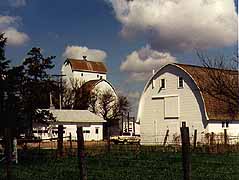
Architecture
At Fort Kearney we have to make a decision. This is where all
the various Trails converged. Independence, St. Joe, Council Bluffs..
wherever they started from, the wagontrains all struck the highroad
here on the banks of the Platte. Mormon Trail, Oregon Trail, California
Trail. Which one shall we backtrack? The river makes a gentle
northeast loop from here, downstream to the Missouri at Omaha
(Council Bluffs). That was the jump off point for the Mormons
in 1847, ‘48, and after. The Gentile Trail slants southeast across
a corner of Kansas, to Kansas City. That’s where most of the emigrants
first marshaled their wagons.
We’ve got two possible sites to visit. Out of dozens, of course,
but two tug our imaginations today. The Willa Cather House, down
by the Kansas border, and the Joslyn Collection in Omaha. Where
ALL the Bodmers are. Peggy calls the Joslyn to see if it’s open,
and if any Bodmers are actually on exhibit. She comes back to
the Owl hooting softly. There’s a room full of Bodmers. Omaha
it is.
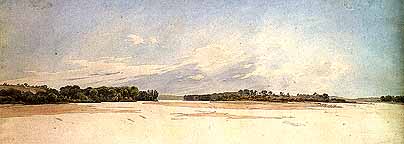
Mouth of the Platte
(Karl Bodmer)
We follow the west bank of the Platte to Central City, then cross
what is now a serious river, not just a string of mud holes, and
cut across the arc, through Osceola, Shelby, Rising City. The
land is rising and falling, real rollercoaster country, like the
Iowa we’re approaching. From the tops of the big rises you can
see three, four, five undulations of the twolane, making like
a Grant Wood. The fields are patterning up in corn rows sprouting,
alfalfa greening, and the fallow beige. Church steeples poke up
into the sunlight. The first tall churches we’ve seen out here
in God’s country. We have yet to spot an anti-abortion billboard
or a brimstone quote. Folks proclaim their religion a bit less
loudly where there’s so much sky watching, maybe.
They are plain spoken, though. We stop for relief at a convenience
store where the sign reads: “UNSUPERVISED CHILDREN WILL BE KIDNAPPED
AND SOLD INTO SLAVERY.”
The roadfood guide has our mouths watering about a cafe in Wahoo. Peggy reads the entrees with a groan. I’m passing the Saturday strollers and going airborne on the downslopes. Wahoo, here we come. Only problem: the cafe has disappeared. Drooling miserably we quarter the town trying to find an alternate bistro that isn't a bar or steakhouse. There are no Yahoo!-s in Wahoo, except for us. We break out the Boulder cheese and sourdough... again.
Then we’re converging with the hills of Omaha. Striking the plush
suburbs first, where the new highways are still under construction.
Looks like a boomtown out here. Immense houses on postage stamp
lots carpet the hillsides. Are these really all families with
a house full of rug rats? I ask. Just the new upper middlers,
Peggy responds. Twenty miles later, when we pass through the old
upscale suburbs, formidable foursquares in brick and slate and
iron mullions, they seem much more modest. Our affluent edifizing
gets bigger all the time. But it’s all interior acreage. Big boasts,
but inside lives.

Salamander
(Bodmer)
Omaha is scrubbed clean, and it’s empty on a Saturday afternoon.
Except for the Joslyn parking lot, which is jammed, and the overflow
lining the streets around. There’s a college commencement happening
in the museum, and they wave us in at the door. “Don’t bother
with the admission fee. The place is packed already.” Fortunately
not the Western Art Galleries. We have Bodmer all to ourselves.
(Memo #102)
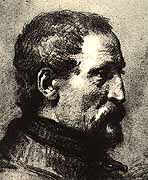
Karl Bodmer
(by Millet)
May 3 Bodmer’s Art
Who? artist Karl Bodmer
What? drawings and paintings
When? 1832-34
Where? Joslyn Art Museum, Omaha, Nebraska
How? accompanied Prince Maximilian on trip through West
Topics: Western art, images of the west, ethnography through art,
royal tourism
Questions: How did Karl Bodmer wind up painting the US west? What
was his specific vision? How is he like/unlike other painters
of the American West?
It’s really rewarding to track down a specific artist and discover his/her collection is in one place that you can visit. We have done a lot of looking at Western art and a lot of reading. We love Remington and Catlin and became intrigued by a Karl Bodmer. Bernard DeVoto’s book Across the Wide Missouri had illustrations by Karl Bodmer that were listed as being in the Joslyn Museum in Omaha, Nebraska.
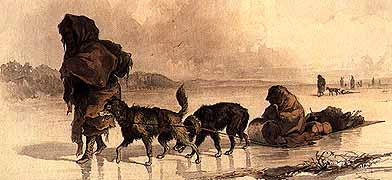
Dogsled
(Bodmer)
This morning we were in central Nebraska deciding on our day’s
destination - should we turn southeast toward Kansas City or head
a bit northeast toward Omaha following the lower Platte to where
it joins the Missouri? The guidebooks said nothing about the Bodmers
at the Joslyn though they said there was a "fine collection of
European and American art." Suppose the museum was closed (as
some have been), or the Bodmer collection in storage? Why not
call? So I called ahead and was told there was a large gallery
full of Bodmers.
The Joslyn is a huge modern building on a hill near the capital.
One wing is faced in beautifully figured pink marble. There are
a few monumental abstract sculptures on the lawns. It is a comprehensive
art museum with a bit of everything from Greek pottery to Jackson
Pollock, more than we could possibly view in an afternoon. Sigh.
We headed for the American galleries.
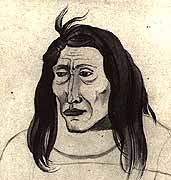
Blackfoot Chief
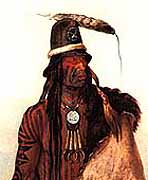
Hidatsa Chief
There was wonderful twentieth century American art - Marsden Hartley,
John Sloan, Thomas Hart Benton, Grant Wood, Charles Burchfield,
John Steuart Curry. Many landscapes in a variety of styles. A
special exhibit on recent images of the Plains. There are paintings
by the Hudson River school painters who toured the west - Bierstadt,
Moran, Cole, Inness - which combine "meticulous realism with a
romantic vision." The museum has two large collections, by Karl
Bodmer and Alfred Jacob Miller. It also has the only Center for
Western Studies in the USA.
Artists went west to discover and to record. Moran and Inness
and Church toured and picked their sights/sites and did many preliminary
drawings. Often the actual oil was done back in the studio. They
captured scenes that projected their image of the West. They used
the "wide lens," trying to capture huge scenes (even on small
canvases).
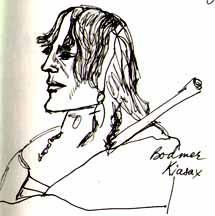
After Bodmer
(Peggy)
George Catlin dedicated himself to documenting the West. It was
a conscious task. He traveled from 1830-36 and produced 600 pictures.
He later took his Western paintings to London and Paris. His large
Indian portraits have become famous; they capture Native Americans
in formal portrait poses. He is the Stuart and Copley for the
Plains tribes. We have seen many of his small landscapes, some
have a whimsical primitive style, a picture of a vast prairie
dog town, for example. In the Joslyn there is a wonderful small
Catlin of a buffalo hunt in winter with the Indians slogging after
the buffalo on snowshoes.
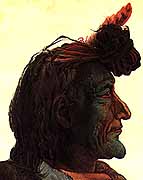
Profile by Bodmer
Karl Bodmer had a different task. He accompanied the German naturalist,
Prince Maximilian, on a tour of the West in 1832-34. Maximilien
had done an earlier tour of Brazil. Bodmer was the eyes of the
expedition, recording, documenting, describing. He captured the
daily landscape. He painted the huge vistas and small animal specimens
on the spot. There are wonderful paintings of river banks and
of the high Plains. There are watercolors of frogs. There are
many small watercolor portraits of tribesmen and women with detailed
costumes (feathers and face paint and fur trim). There are pictures
of Indian villages and Plains forts. There are highly detailed
pictures of tools.
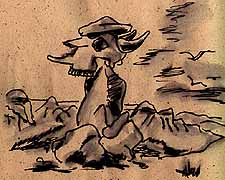
After Bodmer
(Bryce)
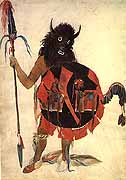
Buffalo Bull Dancer
Bodmer and Maximilian traveled up the Missouri River under the
protection of the American Fur Company. They stayed five months
at Fort Clark, N.D. They saw Indian battles and toured Mandan
and Hidatsa villages. They kept extensive notes and diaries. The
sites and times of Bodmer’s paintings can be pinpointed (“done
after dinner on June 6.”). He was constantly sketching. The spectacular
Bodmer book produced by the Joslyn shows how he worked, the stages:
a pencil landscape with one section in detailed watercolor, preliminary
pencil sketches of groups and then finished portraits of individual
figures.
The large collection of Bodmers on display allowed us to really see his technique. Many of the works are watercolors on brown paper. The pictures are notebook or portfolio size and need to be seen up close. He used pencil to quickly catch the scene or the person in precise yet fluid outline, then watercolor for color and detail, often in several “layers”. Some pictures are merely a quick pencil sketch with sienna and white over it to model and highlight forms. There are subtle watercolors of almost featureless river scenes with large areas of single faint color. He is a superb draftsman! The wild animals are accurate, the men and horses are well proportioned (we’ve seen some pretty weird animal anatomy in Western art! ). He was working fast and he had amazing technical control with pencil and brush. In the more finished pieces, the feathers have individual hairs, the fur is deep and layered. Bodmer detailed expressions and topknots and individual beads. He shows the layer of ashes swabbed on the faces of mourners. His people are very much individuals. There is a precision and control to all he does, but it doesn’t overwhelm. His pictures are NOT clinical. They are also not overly romantic. You can do ethnographic study of Plains tribes through his works or appreciate them as beautiful pieces of art. It is a stunning collection.
5/3.. cont.
I’d been tantalized by DeVoto’s tales of Bodmer, and captured by the illustrations
in Across the Wide Missouri, but seeing one haunting portrait of an Indian out of time in
the collection at Cody, had me longing to see the Joslyn Collection
in Omaha. I’d expected Bodmer’s paintings to be effective illustrations
of a vanished time. I was rocked by their power as transcendent
works. Watercolors technically as good as anyone’s, but inspired
by the world he was discovering. Examples of the paintings he
did before he struck the West reveal how much the power of place
can empower an artist’s work. I can smell the campfires and the
furs and the greasepaint in his portraits, and his landscapes
of the upper Missouri are to bow down before. Here is the landscape
master I’ve been seeking. Maybe I could just move into a corner
of the archive? And these were just forgotten works of a minor
artist languishing in some dusty corner?

Snags on the Missouri
(a nondescript landscape)
There are wonderful Catlins and Millers and Kings here, too. Miller,
particularly, is a master of the watercolor quick-sketch (if stylized).
The height of my ambition. But the Bodmers.. sigh. We shouldered
our way out through the capped and gowned grads, and their families
clicking Kodaks, blinked at the broad 20th century daylight, and
rolled downhill to the Big Muddy.
Urban renewal continues to modernize the Omaha skyline, although
it’s still as flat of affect as the prozac plains to westward.
They were about to dynamite a superannuated skyscraper on Dodge
Street as we drove past. Spooky to see a building on its last
legs, skinny steel ones. All the rest of the ground floor jackhammered
away, and bundles of explosive wired to the naked framing. Sometime
after midnight, the cops said, so we didn’t malinger for the show.
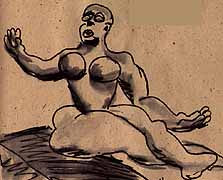
Henry Moore Sculpture
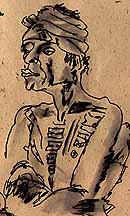
After Bodmer
Over the river without catching sight of any of the bridging.
We never saw the Missouri crossings at Sioux Falls, either, or
much of the river. Into Iowa, and along the flats beneath the
bluffs, Council and otherwise. More narrowly defined country,
this. Enclosed by a glacial backdrop. Tidy farmsteads backed up
to the abrupt hills. Varied patterns of mixed agriculture. More
house pride. Brighter paint. And the lushening verdure of a moist
Spring countryside. Hardwood buds just leafing out. Blooming trees.
Wildflowers in roadside riot. We really hadn’t factored humidity
and altitude into the Spring mix, before this excursion. High
and dry Nebraska is more like Maine in its calendar, and well-watered
Missouri is closer to the South.
We went south into Missouri, and carried on as far as St. Joseph.
There the wagonmaster insisted we circle the wagon and feed the
stock. Tomorrow we’ll get the rest of our outfit in Westport.
Send our last mail back East.
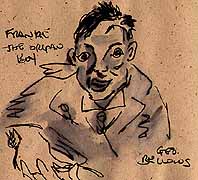
After Bellows